#weirdhistory
Text




Bizarre Dayalets' Hellish Vitamin Mascots used to promote a Healthy Diet in the 1950s
#dayalets#vitamins#mascots#1950s#weirdhistory#advertising#healthydiet#blackandwhitephotography#bizarre
39 notes
·
View notes
Text
Handfasting Was Once a Ceremony for a 1-Year Marriage Trial

Today, handfasting is steadily becoming a common wedding custom where a cord or ribbon is tied around the hands of the bride and groom. Later in history, it was commonly used as a term for a clandestine marriage, and some sources say that later than that, it was more of a trial marriage.
Essentially, a couple who was handfasted entered a trail marriage which lasted a year and a day. If, at the end of that time, they decided it was not working out, they could both decide to not make the marriage permanent.
If the wife found herself pregnant, the child would not be seen as legitimate, but would be taken care of by the father. 1
While all this might sound silly, to Scotland, it was a way to ensure a happy marriage. After all, it was a way to test to see on if you could actually stand being married to someone for life.
Sometimes, whole lineups of couples would be married at fairs or festivals.
"According to tradition , a spot at the junction of waters known as the Black and White Esk , was remarkable in former times for an annual fair which had been held there from time im memorial , but which exists no longer . At that fair it was customary for the unmarried of both sexes to choose a companion , according to their fancy , with whom to live till that time next year . This was called handfasting , or hand – in – fist . If the parties remained pleased with each other at the expiry of the term of probation , they remained together for life ; if not , they separated , and were free to provide themselves with another partner ."
Old Scottish Customs, Local and General by Ellen Emma Guthrie 1885
There is a common assumption that it was only the common-class people who entered these trail marriages, but some of the wealthy or high-ranking did as well.
"This “ on trial ” marriage system seems to have been the fashion with ladies of high degree as well as with the Eskdale lasses and lads.
Lindsay says That James , sixth Earl of Murray , had a son by Isabel Innes , daughter of the Laird of Innes , Alexander Dun bar , a man of singular wit and courage . This Isabel was but handfasted to him and deceased before the marriage .
”Folk Lore in Lowland Scotland by Evelyn Blantyre Simpson (1908)
It was not, however, seen as acceptable to the whole of Scotland, and eventually met it’s end at the hands of the church.
"Hand – fasting was deemed a social irregularity by the Reformers , and they strove by every means to repress it . In 1562 , the Kirk – Session of Aberdeen decreed that all hand – fasted persons should be married . With the exception of the Highland districts , the time – honoured practice of living together for ‘ ” a year and a day ” ceased to exist shortly after the Reformation."
Old Scottish Customs, Local and General by Ellen Emma Guthrie 1885
Luckily, the ceremony found a way to survive as people incorporated it into actual(non-trail) marriages.
Supposedly, it is from this ceremony that the saying “tying the knot” comes from in regards to marriage.
CITATIONS
1
"Mr. Guthrie , in Old Scottish Customs , says , “ If either of the parties insisted on a separation and a child was born during the year of trial , it was to be taken care of by the father only , and to be ranked among his lawful children next after his heirs . The off spring was not treated as illegitimate , because the custom was justified being such and in stituted with a view of making way for a happy , peaceful marriage ."
Folk Lore in Lowland Scotland by Evelyn Blantyre Simpson (1908)
#wedding#marriage#scottish wedding#scottishwedding#pagan#scottishpaganism#ScottishHistory#PaganScotland#WeirdHistory#Folkmagic
12 notes
·
View notes
Text
The Wrath of Rampjaar: The Death and Destruction of Johan De Witt
The 1600s was a difficult chapter for human life. All over the world wars tore at the seams of land and families, and those that did not fall in battle found themselves vulnerable to falling from disease and plague brought on by forces that could not yet be understood. Many things that could not be explained resulted in further violence, fanaticism, death, and destruction dealt from one hand only to be horrifically felt by the other. Breakthroughs in science, exploration, and the arts collided with religious extremism and prejudice as humanity as a whole spun on, seemingly with chaos in every corner.
The Netherlands were one part of the world with turmoils erupting within their borders. In 1672 the country formerly known as the Dutch Republic was seeing the end of the “Dutch Golden Age” with simultaneous wars with England, France, and two German cities. The year 1672 would enter the history books as the Rampjaar, The Disaster Year. The Dutch people coined a phrase to describe this most unfortunate time: “The people were irrational, the government helpless, and the country beyond salvation.”

Allegory of the Disaster Year by Jan van Wijckersloot (1673). Image via Wikipedia.
Although it was obvious there were multiple problems facing the Dutch Republic in the 1672, some believed the problems took root decades earlier. William II Prince of Orange died of smallpox in 1650 leaving the Dutch with no official leader (referred to as a Stadholder.) It was this same year that Johan De Witt began to make his mark in the politics of the region. Johan’s family were bitter rivals of the Oranges and as De Witt began to move up the political ladder he allegedly (with the help of his powerful father who spent time in prison for his involvement in a coup d'etat of William II) quietly made moves and had words written into political documents to keep the young William III or any member of the Orange family from ruling. This allowed wheels to be set in motion to form a fully Republican regime with De Witt at the helm. After holding a number of high-standing positions he was elected to the role of Grand Pensionary of Holland in 1653, essentially making him the ruler of all Dutch provinces.
By the time the 1672 Year of Disaster loomed over the Dutch Republic the people had already endured enough war and horror to last a lifetime under the eye of Johan De Witt. There were the Anglo-Dutch Wars which threatened the land, but De Witt remained focused on the sea, taking every step possible to protect the economic interests in shipping and trading that filled his pockets while paying little mind to the forces surrounding the Dutch at their front doors. He also made it a point to delay the appointment of William III as captain general. The stubbornness of De Witt would have deep consequences when in May 1672 Louis XIV invaded the Dutch Republic, thus beginning the third Anglo-Dutch War.

Portrait of Johan De Witt by Adriaen Hanneman (1652). Image via Wikipedia.
As troops moved straight into the heart of their homeland the exhausted Dutch people felt betrayed by their leadership and all eyes turned to Johan De Witt. Some were content to simply, but loudly, voice their opinions that the House of Orange should take back their power by any means necessary. Others showed their feelings of anger and betrayal in much more aggressive ways. On June 21st 1672 Johan De Witt was attacked by a man who was armed with a knife and an intent to kill. The assailant did succeed in brutally stabbing him, but he survived. Johan’s brother Cornelis was also feeling the pressure of the simmering public and on July 24th he was arrested under charges of treason against the House of Orange. He was brought to prison in The Hauge where he was tortured in order to obtain a confession. While his brother was recovering from being nearly assassinated, Cornelis was refusing to confess to any wrongdoing and was eventually sentenced to exile.
Being attacked with a malicious blade changed De Witt and after a lengthy recovery he resigned from his position on August 4th 1672. At the time of his resignation his brother Cornelis was still wallowing in prison with his exile looming. On August 20th Johan visited his brother at the prison to assist him and see him off on what was supposed to be his date of forever departure from his homeland. It is unknown what the pair discussed that day, but it is almost certain they had no clue what was about to happen. Yes, Johan resigned and Cornelis was exiled, but the Dutch people were not ready to let the brothers walk peacefully away into a new chapter while they were left with suffering and debt that could follow them for generations. As the brothers talked in the prison they were attacked by a mob that were set on tearing them limb from limb.
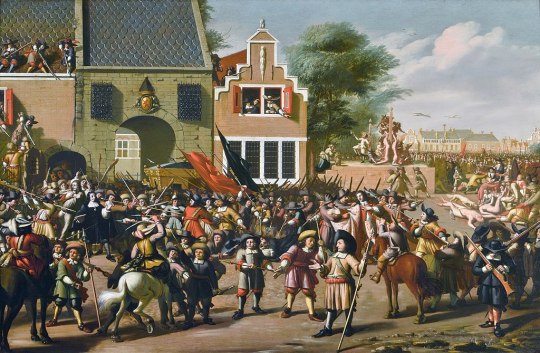
The Murder of the de Witt Brothers by Pieter Fris. Image via Wikipedia.
What unfolded was a scene that was feral, ferocious, and that has gone down in history through eyewitness accounts and multiple pieces of art. The mob ravaged the De Witt brothers. They were dragged into the street, shot, stripped of their clothing, and taken to the public gallows. If the brothers thought their end would be found in a broken neck at the end of a hangman’s noose they were terribly wrong. Once strung up the mob began to take souvenirs. Some accounts report that their eyes were stolen, others say they were later cut into pieces and distributed to the masses, and while that is up for debate one thing that is certain is that their bodies were sliced open, their livers stolen, and the organs were then roasted and consumed by those in attendance. After a lifetime of prestige and twenty years in power, Johan De Witt departed life alongside his brother after being mutilated and cannibalized by his own countrymen.
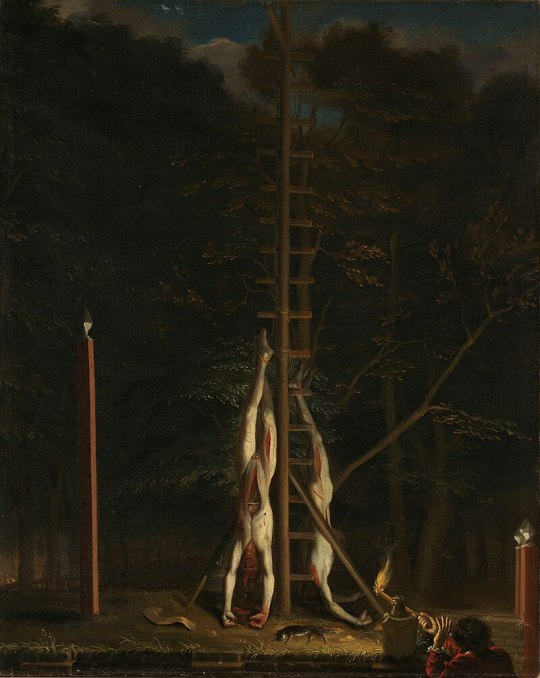
The Corpses of the De Witt Brothers by Jan de Baen. Image via Wikipedia.
With De Witt gone power went to William III of Orange, the same man who had his appointment as captain general stalled by De Witt and the son of William II whose death was used by De Witt and his father to make the turn to the Republican force that they hoped would keep the House of Orange out of power for good.
Whether William III had a hand in planning the attack and death of the De Witt brothers is debated to this day with answers unknown.
Today the prison where the De Witt brothers spent their last moments on earth still stands and has been repurposed as a history and art museum.
**********************************************
Sources:
That Time the Dutch ate their Prime Minister by Vlad Moca-Grama. DutchReview.com, March 3rd 2023. https://dutchreview.com/culture/dutch-history-crowds-ate-prime-minister/
A Dark and Stormy Bite: That Time a Bunch of Dutch People ate Their Prime Minister by Lillian Stone. TheTakeout.com, January 15th 2021. https://thetakeout.com/a-dark-and-stormy-bite-that-time-a-bunch-of-dutch-peop-1846044366
Johan De Witt. Encyclopedia.com.https://www.encyclopedia.com/history/encyclopedias-almanacs-transcripts-and-maps/johan-de-witt
#husheduphistory#featuredarticles#history#forgottenhistory#strangehistory#weirdhistory#tragichistory#historyclass#truestory#truth is stranger than fiction#DutchHistory#NetherlandsHistory#JohanDeWitt#ShockingHistory#horrorhistory#sadstory#HollandHistory
3 notes
·
View notes
Photo
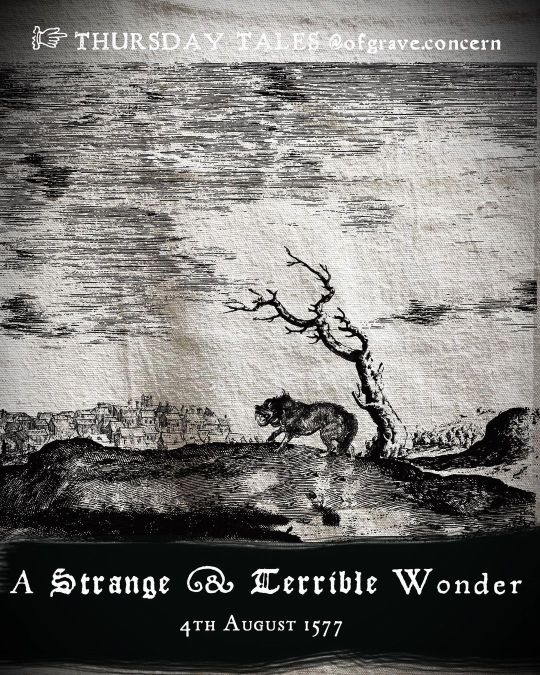
4th August 1577, the infamous sighting of a ghostly black dog in St. Mary’s parish church of Bungay, in the south east of England, during a a great ‘tempest of violent raine, lightning and thunder,’ as the storm shock the church a strange and terrible shaped creature was seen to enter, resembling a hellhound it violently attacked members of the congregation before disappearing. Twelve miles away in the town of Blythburgh, the creature reappeared at the Holy Trinity Church, where it continued its attack of the congregation there. The events were recorded in the same year by the English clergyman, and poet Abraham Fleming (Flemyng). The creature is said to be that of Black Shuck, the name given to a ghostly black dog which is said to roam the coastline and countryside of East Anglia, England. Embedded in the folklore of the area, the name Shuck may derive from the Old English word ‘scucca’ meaning demon or possibly from the local dialect word ‘shucky’ meaning shaggy or hairy. Further north there are also the tales of other spectre dogs, the white ‘Gallytrot’, (‘Gally’ being an old word for fright); and the ‘Barghest’ of York, who enters the city and preys upon travellers in the narrow mediaeval lanes, such as the most famous known as the ‘Shambles’. A Black Dog has also been seen as the site of the Norman motte and bailey castle known as Clifford’s tower, the site of the 1190 massacre of the Jewish population. Despite living for nearly two years opposite the tower, I unfortunately, (or fortunately if the impending doom aspect is to be believed), did not lay eyes upon the creature. (Continued in the comments). #thursdaytales #blackshuck #weirdhistory #darkhistory #cryptids #cryptid #cryptidcore #cryptidsighting #cryptidart #16thcentury #paranormal #paranormalencounters #ghostly #monstersamonguspodcast #portents #ghostdogs #strangehistory #strangehistoryfacts🤔 #mythology #hellhound #hellhounds #mythologicalcreatures #mythsandlegends #mythological #mythologicalart #gothictales #blackdog #cryptozoology #cryptic_aesthetic #paranormalhistory https://www.instagram.com/p/Cg1_ouAOLSn/?igshid=NGJjMDIxMWI=
#thursdaytales#blackshuck#weirdhistory#darkhistory#cryptids#cryptid#cryptidcore#cryptidsighting#cryptidart#16thcentury#paranormal#paranormalencounters#ghostly#monstersamonguspodcast#portents#ghostdogs#strangehistory#strangehistoryfacts🤔#mythology#hellhound#hellhounds#mythologicalcreatures#mythsandlegends#mythological#mythologicalart#gothictales#blackdog#cryptozoology#cryptic_aesthetic#paranormalhistory
29 notes
·
View notes
Text
youtube
0 notes
Text
Embark on a delightful journey through the weird history of the Tooth Fairy with our blog. Uncover the enchanting origins and evolution of this beloved childhood icon. From ancient traditions celebrating the loss of baby teeth to the modern fairy tales we know today, we explore the whimsical world of tooth-related folklore.
Discover how the Tooth Fairy emerged in early 20th-century America, swiftly becoming an integral part of childhood magic. Take a global tour of diverse tooth-related traditions, each offering a unique spin on celebrating this rite of passage.
Delight in fun facts and whimsical tales about the Tooth Fairy's global adventures, from unique tooth exchanges to extraordinary tooth towers.
Join us on this captivating exploration and visit our site - Weird History: The Tooth Fairy
Contact Us - 281-579-8700
Address - 20660 Westheimer Pkwy, Suite A, Katy, TX 77450 USA
Visit Us - Kids Healthy Teeth
#ToothFairyMagic#ChildhoodTraditions#EnchantingHistory#KidsFolklore#WhimsicalJourney#ParentingMagic#DentalMythology#MagicalChildhood#CulturalTraditions#KidsImagination#FolkloreExploration#ParentingInsights#GlobalToothCustoms#ChildhoodMemories#FamilyFun#KidFriendlyStories#MagicalMoments#ParentingJoy#FunWithKids#WeirdHistory#ChildHealthBlog#PediatricDentalCare#KidsOralWellness#FamilyHealthTips#GumsBleedingCauses#OralHealthGuide#PreventiveDentistry#ParentingJourney#ChildrensWellbeing#GumHealthAwareness
0 notes
Text
youtube
#NewsofTheTimes#VictorianCrimeStories#HistoricalCrimeStories#marielafarge#marshtest#historicaltruecrime#arsenicpoisoning#horrorstories#weirdhistory#Youtube
1 note
·
View note
Photo

Follow @sharp_blade_roach #whynot #shitpost #fyp #funfact #reddit #explorepage #instagram #weirdhistory https://www.instagram.com/p/Cp8xmLcOIZV/?igshid=NGJjMDIxMWI=
1 note
·
View note
Photo

A new episode of @privycast came out today. And so, I salute all the Star Wars fans. - Link in bio for episode - #podcast #episode #newrelease #privy #privcyast #bathroom #history #cutlure #etiquette #humor #comedy #weirdhistory #toilet #woofy #funny #dontforgettoflush #starwars #starwarsday #maythe4thbewithyou #maythefourthbewithyou #mandalorian #spock (at Albany, Oregon) https://www.instagram.com/p/CdM9W33uJeM/?igshid=NGJjMDIxMWI=
#podcast#episode#newrelease#privy#privcyast#bathroom#history#cutlure#etiquette#humor#comedy#weirdhistory#toilet#woofy#funny#dontforgettoflush#starwars#starwarsday#maythe4thbewithyou#maythefourthbewithyou#mandalorian#spock
0 notes
Text
English Couples Used To Flee To Scotland To Marry

It might seem strange to many now, but historically, many historical weddings in Europe did not involve a church or even a priest.
“Although the church controlled – or tried to control – marriage, couples did not need to marry in a church. Legal records show people getting married on the road, down the pub, round at a friend’s house or even in bed. All that was required for a valid, binding marriage was the consent of the two people involved. “
Love and marriage in medieval England by Sally Dixon-Smith . History Extra
Most commonly, a marriage involved the couple, and perhaps a witness. However, that witness did not always have to be human.
There was once a animist belief that there were spirits in everything, including the waters. When people would visit a healing well or wishing well, it was to the spirit there that people would leave their offering for. Because of thoughts like these, if a couple wanted to marry in complete secret in Scotland, you could call upon water as witness.
“A bargain made over running water was indissoluble. It is the old calling of water as a witness. Lovers who desired to plight their vows with peculiar solemnity repaired to a burn, stood on opposite banks, dipped their fingers into the water, clasped hands across the stream, and so exchanged their vows. It was thus that Burns plighted his troth with Highland Mary.”
The Silver Bough: Volume 1 by F. Marian McNeill (1957-1968)
It was also because of this that, near Carmyle village(which is now a suburb of Glasgow), there was a spring that was known as “The Marriage Well.” Once, there was two united trees beside it, though they have been cut down.
When it was in it’s prime, people continued visiting (though now after a wedding) to again pledge as bride a groom, and drink from the spring.
"A simple declaration before a witness bound a couple in the bonds of matrimony as securely as red tape did in England ."
Folk Lore in Lowland Scotland by Evelyn Blantyre Simpson (1908)
These weddings, also called “clandestine marriages,” were once very common, though had controversies. Not only did many think the church should be involved, but there was also the thought that the parents should have more control. After all, what if your child wanted to marry someone of a lower status, and you wanted to stop that?
This was where the Marriage Act was introduced in 1754, and soon became law to England. It raised the age of consent to 21 (understandable), but also required all marriages to involve the church and made clandestine marriages illegal.
Despite the change with their southern borders, these marriages remained legal in Scotland until 1940, so people from England would flock to Scotland to be married.
The disregard of the church as the place to make their vows in may have arisen in Scotland from a unique usage called handfasting , or hand in the fist marriages .
"This vogue arose in early Catholic times when travelling was dangerous and difficult , and visits from priests in outlying districts A fair was held annually in the dale where the Black and White Esk met , and there flocked the unmarried of both sexes who sought a companion . When they found one to their mind they were handfasted till the following year . Then if they mutually approved of one another , a priest in course of time when he came by gave them the Church’s blessing ."
Folk Lore in Lowland Scotland by Evelyn Blantyre Simpson (1908)
The most popular escape for couples wanting to partake in a marriage of old, became Gretna Green, which was in Scotland but only just over the border. Couples would flee to there, find two witnesses, and be legally married.
It just so happened that blacksmiths were very likely to always be found in the same spot, and so many people from England were married by a blacksmith.
In Gretna Green, these weddings were so popular, they are still sometimes referred to as a “Gretna Green Marriage” to this day.
“Other Scottish border villages used for such marriages were Coldstream Bridge, Lamberton, Mordington and Paxton Toll, and Portpatrick for people coming from Ireland”
Wikipedia with citations to “Runaway Marriages at the toll house, Coldstream Bridge”, Original indexes
CITATIONS
1
"On the right bank of the Clyde, about three-quarters of a mile from Carmyle village, is the once sylvan district of Kenmuir. There, at the foot of a bank, is a spring locally known as “The Marriage Well,” the name being derived, it is said, from two curiously united trees beside its margin. These trees were recently cut down. In former times, it was customary for marriage parties, the day after their wedding, to visit the spring, and there pledge the bride and bridegroom in draughts of its sparkling water."
Folklore of Scottish Lochs and Springs by James M. Mackinlay (1893)
2
"Marriage ceremonies in London were easily available at a wide range of locations before Hardwicke’s Marriage Act put a stop to clandestine marriages in 1754."
“Clandestine marriage in early modern London: when, where and why?” Published online by Cambridge University Press: 18 July 2014
HISTORIC AUDIO RECORDINGS
(link) A MacDonald in Skye was courting Jessie of Balranald, but her father arranged for her to marry a wealthy man named Cooper. She and MacDonald eloped by boat, but a storm forced them to land in Rodel, where she was caught by her aunt. MacDonald and his friends secured her escape by breaking down the door. They went to Gretna and on to Australia.
#scotland#ScottishHistory#ScottishPaganism#Scottish Paganism#animism#history#ScottishWedding#pagan#scottishhistory#WeirdHistory#PaganScotland#Folkmagic
3 notes
·
View notes
Text
Dealt a Hand of Death: The Terrible Table of the Delta Saloon
When gold was discovered in California on January 24th 1848 it changed the landscape of the country with approximately 300,000 people swarming to the state from all over dreaming of striking it rich and finding fortune in the ground. Undoubtedly, the California Gold Rush was familiar to Henry T. “Pancake” Comstock, a Canadian miner and acquaintance with brothers Ethan Allen and Hoesa Ballou Grosh. The Grosh brothers were veterans of the California gold fields and in the fall of 1857 they discovered a promising ore deposit in Virginia City, Nevada. But, before they could claim the land both brothers tragically died. Hearing of their deaths, Comstock took it upon himself to take over their cabin, open their belongings, find the documentation connected to their find, and essentially claim it as his own. In the spring of 1859, two miners named Peter O’Riley and Patrick McLaughlin began to work the area around Six-Mile Canyon when they made a huge discovery, a deposit of silver ore, but their elation was short lived. Comstock claimed the men were working on land he had already claimed for “grazing purposes” and he proceeded to threaten them to the point that in order to avoid issues the miners made him a partial owner in the claim, later named the Comstock Lode.
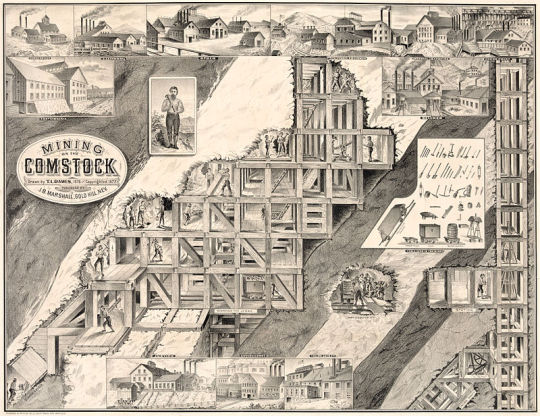
Mining on the Comstock. Image via wikipedia.com.
The men had no idea what they had discovered. The Comstock Lode was a massive deposit of silver ore, the first of its kind in the United States, and news about new riches found under the earth brought back the excitement of the California Gold Rush from less than ten years earlier. From its discovery in 1859 to 1882 the Comstock Lode yielded what would today amount to over ten billion dollars worth of ore. However, none of the men who discovered the claim never saw that level of wealth. Patrick McLaughlin sold his 1/6 interest in the claim for $3,000 but the money was quickly lost and he died after working multiple odd jobs to scrape by. Peter O'Riley held on to his interests at first but eventually sold them for approximately $40,000. He used the money to invest in other endeavors including a hotel and another venture into mining but his attempts were unsuccessful. He lost everything, was declared insane, and his life came to a close in a California asylum.
Henry Comstock sold his interests and went on to open various shops in Carson City and Silver City. He too lost everything in bad business decisions and in September 1870 he died in Montana after shooting himself in the head.
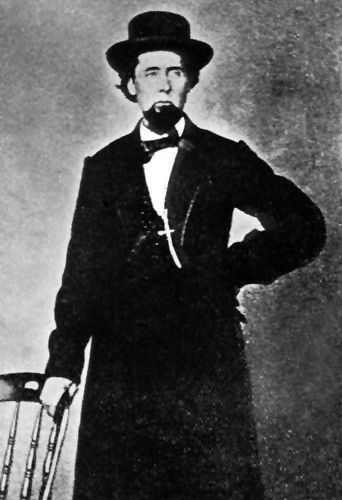
Henry T. "Pancake" Comstock. Image via legendsofamerica.com.
When the Comstock Lode was discovered it completely transformed Virginia City, Nevada. Once a small mining town it was quickly filled with hundreds of thousands of prospectors, driven by the re-ignited dreams of fortune just waiting to be dug up. The influx of people brought everyone imaginable to Virginia City, and it quickly transformed into a place where law dared not tread. Filled to the brim with bordellos, saloons, and opium dens, the city became the darkest definition of the wild west. In 1872 Mark Twain published his semi-autobiographical novel Roughing It where he wrote about his travels by stagecoach through the American West and later the islands of the Pacific. In the book he writes about his trip to Virginia City stating that “Two days before I lectured in Virginia City, two stagecoaches were robbed within two miles of the town.” Twain himself was later robbed at gunpoint once he arrived in the city, losing his money and a gold watch.
Dreams, greed, and human beings all swept through the west and Virginia City, but there was one more thing that was keeping all of their minds occupied, a card game called Faro. Played using one deck of cards and being fairly easy to learn, gamblers quickly made Faro the dominant card game of every gambling hall in the west from 1825 to approximately 1915. One man who was well versed in the game was a Virginia City gambler named “Black Jake” who decided he was going to capitalize on its popularity, buy himself a Faro game table, and make himself rich taking cash out of every pocket he could. He was known for being a greedy man, but one night in 1861 karma came back strong and the table turned on its owner with Black Jake losing multiple rounds and $70,000 in one night. With absolutely no way to pay out that amount of money, the equivalent of two million dollars today, the disgraced gambler grabbed his pistol and took his own life at the table. With Black Jake gone the table needed a new home, and a few years later it found a new owner whose name has been lost to time. This new owner operated the table for exactly one night where he too lost everything, including his life. It is unknown if he chose to take it himself, or if it was taken from him.

Playing Faro in a saloon circa 1895. Image via wikipedia.com.
Having claimed two lives, the table was stored in the back room of where it was last used, The Delta Saloon, where it would sit undisturbed for decades. It wasn’t until the late 1890s that wealthy businessman Charles Fosgard laid eyes on the table, and he was happy to buy it. Fosgard had a lot of money, but he was looking to reinvest it and in Virginia City with its thrill-seeking gamblers looking to strike it rich in the saloons when they couldn’t in the mines, it made perfect sense to Fosgard to bring the notorious table out of retirement. After converting it into a blackjack table, Fosgard went into business.
One night a drunk miner sauntered into The Delta Saloon and made his way to the blackjack table. To Fosgard’s delight the miner lost hand after hand until he only had one thing left to offer the businessman, his gold ring. He bet the ring against a five dollar coin and finally, he won a hand. Then he won another….and then he won another. The miner and Fosgard went face to face over and over again and a crowd grew to watch as the businessman was forced to hand over everything. By the end of the game the miner was the new owner of Fosgard’s stagecoach, his share in a local gold mine, and $85,000 (over 2.5 million dollars in today’s money.) Fosgard’s fortune was decimated and he did the only thing he could think of, he pulled out his gun and took his life at the same table as the previous two owners (and in the same way as not only them, but also the less-than-legit founder of the Comstock Lode that brought them all there.)
The table was soaked in enough tragedy and it was put out of commission with a new dubious nickname of The Suicide Table. Year after year, and as the population of Virginia City depleted, the story of the table only grew and it was eventually made a feature of The Delta Saloon. People came from all over to see the table, guided by a sign that cheerfully read “See the Suicide Table” in bright paint as you approach the building that had been restored as faithfully as possible to how it was in its heyday in the 1800s. The table itself was also restored, brought back to its original state as a Faro table. It stayed a Delta Saloon attraction for decades, saw in new centuries, and lived quietly with its tragic past and infamy.

Vintage postcard showing The Suicide Table on display at The Delta Saloon. Image via ebay.com.
Then, on March 11th 2019, Virginia City was shaken when a gas explosion occurred at The Delta Saloon. Amid the damage sat The Suicide Table, unscathed other than receiving a coating of dust. Movers were brought in and the table was relocated to the Delta’s sister saloon, The Bonanza Saloon, right across the street where it remains on display under protective plastic housing.
The Suicide Table is still a major attraction in Virginia City, attracting the gaze of thousands of people lured in by its horrific past. In a time and place that encompassed the lawless American West like Virginia City, there are many shocking tales to tell. But standing out in the crowd is a simple Faro table, created as a game of chance, and tied to at least four lives suddenly lost in the bloody name of greed.
*****************************************************
Sources:
Step Back in Time Virginia City Nevada by The Virginia City Tourist Commission. 2022. https://visitvirginiacitynv.com/history/
Comstock Lode – Creating Nevada History by Legends of America. 2023. https://www.legendsofamerica.com/nv-comstocklode/
The History and Nostalgia of The Delta Saloon by The Delta Saloon. 2023.
The Old West Card Table With a Deadly Past by Danielle Hyman & Adam Aronson. The Daily Beast. September 3, 2018. https://www.thedailybeast.com/the-old-west-card-table-with-a-deadly-past
Men’s luck ran out at gaming table by Dave Maxwell. Boulder City Review. June 17, 2020. https://bouldercityreview.com/community/mens-luck-ran-out-at-gaming-table-61432/
#husheduphistory#featuredarticles#truestory#forgottenhistory#strangehistory#weirdhistory#tragichistory#history#historyclass#NevadaHistory#mininghistory#goldrush#AmericanWest#WildWest#cursedobjects#gaminghistory#comstocklode#cardgame#VirginiaCityHistory#DeltaSaloon
3 notes
·
View notes
Text
How Coffee transformed the world
Did you know that the simple act of enjoying a cup of coffee has played a major role in shaping the world as we know it?
(A longer version of this article is here https://www.youtube.com/watch?v=PZIm2p04KvE )
Coffee originated in Ethiopia in the 9th century, and it quickly spread across the Arabian Peninsula. It wasn't long before it became popular throughout the Islamic world.
In the 15th century, coffee reached Europe and started a brewing revolution. Coffeehouses became the centers of social and intellectual gatherings, fostering lively discussions and the exchange of ideas.
But it wasn't just about stimulating conversation; coffee also had significant economic implications. It became a commodity that drove trade and colonization.
Coffee plantations started to emerge in various parts of the world. Countries like Brazil, Colombia, and Vietnam took advantage of the ideal climate and conditions to cultivate coffee beans on a large scale.
These plantations led to the growth of entire industries, providing jobs and livelihoods for millions of people worldwide. They also fueled technological advancements, from steam-powered machinery to modern packaging techniques.
Today, coffee is the second most traded commodity globally, after oil. It has become an essential part of modern society, with millions of people relying on it for their daily dose of energy and enjoyment.
So next time you sip on that aromatic cup of coffee, take a moment to appreciate the impact it has had on our world. Cheers to coffee revolutionizing the world's beverages!
#coffee#beverage#world#revolution#coffeeaddict#coffeelover#weirdhistory#caffeine#coffeebreak#coffeeislife
0 notes
Video
youtube
The Cardiff Giant
0 notes
Video
youtube
Little American Mummy | A Disturbing Unsolved Mystery | BLUE Video 1
0 notes
Video
youtube
"Cosmic Visions & Tech Triumphs: From Webb's Gaze to Musk's Space Odysse...
#youtube#WeirdHistory Top15 Facts TopDiscovery JamesWebb TerrifyingDiscoveries ScientistsDiscovery DiscoveryPlus ElonMusk DiscoveryChannel Interestin
0 notes